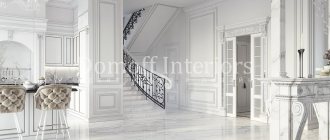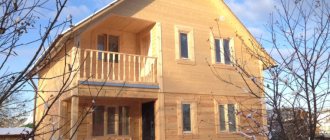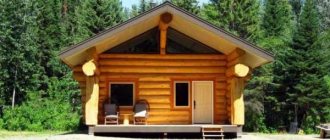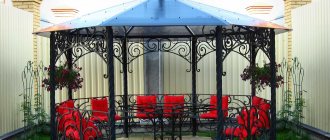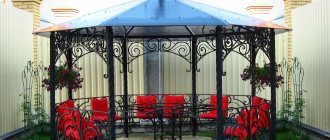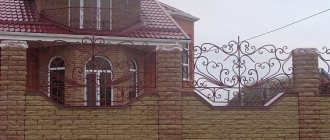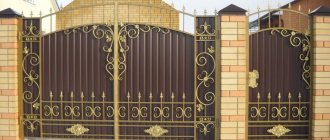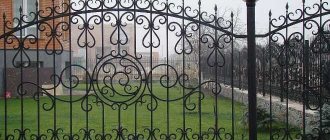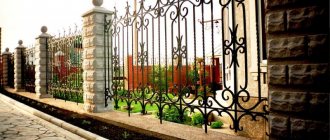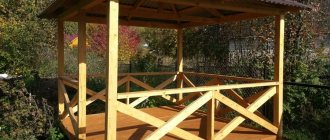Styling your home with metal furniture and decorations allows you to create a unique design. This is why artistic forging in the interior looks really good and unusual. Stairs, sofas, armchairs, chandeliers - all this is made by craftsmen from iron, copper, aluminum. Their combination makes it possible to achieve strength and an original appearance of structures. They can also be used to decorate the yard and facades. When choosing suitable models, the basic style, dimensions and characteristics of the structures should be taken into account. The color scheme also plays an important role. Many craftsmen treat finished models with patina and hammer paint. Non-standard transitions of tones and aging of structures allow us to obtain stylish models that will be a good complement to ultra-modern and classic design.
History of the use of forging in the interior
Craftsmen began forging different types of products for decorating rooms and facades back in the Middle Ages. But at this time, special importance was not attached to the originality of designs. For example, they were characteristic of the Romanesque style in the design of architectural buildings. True, they were used to a greater extent due to reliability and durability. From the 17th century, balcony railings and staircase railings began to become thinner and complemented with various decorations. They were often decorated with thin silhouettes of vases and grapevines. This trend came from the Greeks. Later, each type of furniture, decorations is improved according to popular trends. They were used mainly for decorating homes and residences of famous people. For example, many Romanov palaces are framed by unique lattice fences with various patterns. Such designs have survived to this day and are used as examples to follow.
Artistic forging - what is it?
It is the production of refined products by hot or cold processing of various metals and their alloys. Such items appear highly detailed, more reminiscent of jewelry work rather than simple craftsmanship performed with hammer, flame and anvil. Artistic forging is used not only to create external architectural elements of a building, such as railings, window grilles or gates, but also for more interesting paraphernalia, which in itself is of high value, since it is made by the hands of a master and, most likely, according to an individual sketch , no longer exactly repeatable by other creators. That is why forged accessories in the house are usually found in aristocratic mansions or expensive city apartments.
Artistic forging made of aluminum in a long corridor serves as a decorative component of the room
Look at the project : Interior of the Zhedochi house.
Advantages of forged products
The elegance and attractiveness of artistic forging is its main advantage. Metal mirrors, clocks, and furniture allow you to decorate your home in an original way. They can be used to decorate any part of the apartment. But exclusive models also have a number of other advantages:
- durability (they are not afraid of moisture, the models are resistant to mechanical damage);
- ease of care (soft rags or pipidastra can be used for cleaning);
- mobility (when moving, you can take the purchased furniture with you, the only exception being stairs);
- versatility (suitable for rooms with any style, you just need to choose the right model according to color and decoration features);
- ease of combination (with each other, with furniture and interior decorations made of different materials).
Decor and accessories
Artistic forging has not lost its relevance for the exterior: the use of this method of making forged gates, fences, decorations for personal plots and landscape design is a classic.
But forging returned to the interior just a couple of years ago, when designers again paid attention to it and gave it a more modern and minimalistic look. The main use of artistic forging today is accessories. Various decorative items are made from metal: from mirror frames to lamps. Let's take a closer look at forged products.
- Mirrors. Forged elements on frames are the same standard technique for framing mirrors as wood. Due to their strength, mirrors of different thicknesses and sizes are placed in metal frames. Models are wall-mounted, floor-mounted, with shelves or hooks. Form - no restrictions. The flexibility of the metal allows you to bend not only a standard circle or rectangle, but also an oval, wave, drop, etc. Forging looks especially luxurious in the interior in combination with the arched shape of the mirror.
- Watch. If earlier the mechanism was richly decorated with forged elements such as leaves, clusters, flowers, then modern design assumes straight lines and a minimum of details. The most popular model: round with Roman numerals.
Look at examples of using clocks in the interior.
- Decorative panels. Wall decoration does not have to be functional - artistic forging in the form of a certain plot looks much more original in the interior than a painting or photo in a frame.
The photo shows a forged panel
- Lamps. Forged products in the interior often play the role of lighting fixtures: chandeliers, sconces, lanterns, even floor lamps and table lamps are popular. Before purchasing, the main thing is to make sure that the metal will fit into the design of the room.
- Flower stands. The classic use of forging in the interior is an openwork flower stand for 1 or several plants. The metal construction is both durable and visually lightweight, making it a dream for most gardeners.
- Fireplace and stove grates. In private homes, one cannot do without such an interior item as a fireplace screen. It combines a decorative function with a protective one, preventing burning logs from falling out of the stove.
- Stair railings, fences, partitions. Artistic forging is often used when it is necessary to fence a staircase or an open area on an elevated surface. Forged products in this case look lighter, do not weigh down the space, and do not block the view.
In addition to the listed methods of application, statues or figurines, handles for entrance and interior doors, curtain rods, candlesticks and much more are also made from this material.
What styles are they used in?
When selecting non-standard metal decorations and furniture, you must take into account the style of the interior. The predominant geometric shapes and patterns will allow you to find suitable models. When searching, you can also use the following hint:
- Provence;
The model should include thin floral and foliage parts.
- Scandinavian;
Strict geometry and the absence of smoothed details are the main selection criteria.
- rococo;
For this style, products with refined lines and transitions to massive jewelry are suitable.
- Oriental;
The finest ornate weaves and wavy transitions are considered the most suitable for this direction.
- loft.
“Rough” transitions, sharpness, and the predominance of precise geometric shapes are the main selection criteria for this style.
When choosing decorated products, you need to take into account compliance with the color scheme of the room in which they are installed. For example, for the Scandinavian style, models with white, black, and gray colors are suitable.
What is the color of forged or cast metal?
If we talk about the color of forged products, then it can be a shade of the manufacturing material itself, without changing its metallic appearance of natural origin (aluminum, steel, cast iron, nickel, copper, etc.). Objects made by a blacksmith are often doused with various chemical compounds that give an unusual effect, and are also covered with precious compounds. Modern technologies make it possible to create a slightly moldy patina that will look great in a classic style, or to luxuriously gild details, such as in baroque, rococo, eclecticism, art deco, ethnic or oriental styles. Products made from alloys like Damascus steel look incredibly beautiful, especially if it is a victorious Empire style.
The modern fireplace is skillfully decorated with unusual forged elements with a slight blackening
In the living room
The spacious living room is ideal for placing stylized models with metal decorations. These include chairs, tables, sofas. Also in a spacious room can be installed:
- stands for flowers (allow you to create special comfort and harmony, free narrow window sills from pots with plants);
- shelves for books and souvenirs (provide compact and stylish storage of various small items and personal items);
- coffee table (suitable for tea parties, storing books and magazines, installing vases);
- chandelier (will complement the overall picture and emphasize the style of the room being created).
If the design of the room allows, then it should be supplemented with clocks, mirrors with metal frames and decorations. All selected models must be made in the same style.
Bathroom
Increasingly, forged decorative items can be found in restrooms. And it is not surprising, since many metal products, for example, stainless steel, do not corrode, and if over time they acquire some undesirable shade, then this is fixable and not at all so critical, especially in comparison with short-lived materials that deform from constant humidity. Therefore, in luxurious mansions, bathrooms are richly decorated with paraphernalia made by the hands of a master blacksmith. These can be laconic carved legs for an oval bathtub standing in the middle of the room, a wall-mounted lace cabinet for a washbasin, twisted edging of large mirrors, as well as sophisticated sconces and hanging chandeliers. Forged products are an unconditional exclusivity that will never go out of fashion.
Forged elements of a strict modern type indicate a clear elaboration of the style of the bathroom
The silver bathtub legs are hand-forged especially for this bathroom design project
Elegant wrought iron details on the sink and mirror complement the classic style of the spacious powder room.
Wrought iron chairs in the interior
Armchairs with metal frames are designed as close as possible to royal styles. Unusual models can be used for installation in halls and dining rooms. Some are part of a ready-made dining group where the whole family will gather to eat. Some are in addition to the sofas located in the spacious rooms. Many models are equipped with armrests. They can be refined or massive. The upholstery has different designs. Jacquard and velvet fabrics are often used to make furniture. Canvases with patterns in the form of stripes and filigree patterns are ideal. Abstractions and images of animals and people are not used for metal furniture. They look out of place in a composition with a massive frame. Less often, leather or suede is chosen as upholstery.
Kitchen and dining area
Furnish an already exquisite kitchen with forged decorative elements or furniture made by a blacksmith - and the royal island is ready not only to receive the owners, but also their guests, surprising with the beauty of the curling details. The table leg, chair backs, handles on the hinged doors, shelves for dishes, hooks, bottle stands will add amazing charm to any cooking area or dining area for everyday meals and entertaining invited gentlemen.
The forged edging of a wall clock in a classic elegant kitchen adds charm to the decor
Black forged lamps in the Gothic style look very unusual and elegant
Metal decor in the form of flowers on the kitchen wall is made by hand-made artistic forging
Forged stairs
The wrought iron staircase in the hall completely changes the overall appearance of the room. It visually expands the space. It is worth selecting the design and type of staircase based on the size of the hall (or corridor) and its design. For a small area, an L-shaped staircase or a straight staircase are suitable. But exquisite screw designs are recommended to be installed in spacious halls. The design of the railings must be carefully selected to match the style of the room being created. When creating an ultra-modern trend, it is recommended to opt for an all-metal structure. For a classic style, a combination of iron railings and marble steps would be appropriate. For other directions, models with wooden steps are ideal. Taking these features into account will help you choose a staircase with the most suitable design.
Hall and hallway
Perhaps the most popular place for installing large forged objects is the hall, since it is there that an unusual staircase can be located: either made entirely of cast iron, or having most of the components made of some kind of metal, coated with silver, gilding, or plainly painted white or another color. Openwork balusters and railings are where the aesthetics and spirit of a real castle lie. Cast steps and carved railings in the interior will certainly become the main accent of the room, which you will want to look at every time it comes into view. The hallway can also be decorated with various forged items, showing with all its appearance that this is the home of art lovers.
Gilded forged product of the author's handicraft as a wall table in the hall
The classic hall with a wide staircase is professionally decorated with white painted wrought iron elements
Openwork forged parts of an unusual color with a cold undertone on the stairs and railing of the second floor of the classic hall
The designers decorated the hall of the second floor of the country house with a wrought-iron shelving to enhance the effect of stylish antiquity.
In the bedroom
Exquisite bedroom decoration is easily achieved by using metal furniture. It includes a bed, a dressing table with a mirror, shelves for books and flowers. A bench made in a similar style will help to complement the sleeping bed in an original way. It is important that to create an attractive design, you can replace all the usual furniture and lamps. For example, replace regular sconces with sconces with metal filigree frames. But the bedside table can be replaced with a bedside table with a refined frame and glass top. Installing a coffee table along with a pair of chairs will also help to add coziness and comfort to the overall appearance of the room. They can be placed near a window or opposite a wall decorated with pictures or a mirror. This composition will look sophisticated and elegant.
Examples of combinations with other materials
Forged products for interior use in residential premises are rarely solid metal: for greater functionality and comfort, forging is diluted with other materials.
Tree
Cold forging in combination with warm wood becomes more comfortable and neutral. The seats of stools or chairs, table tops, and shelves can be made of wood.
The photo shows a combination of wood and metal
Glass
The glass + iron duet looks cold on one side, and light and airy on the other. A glass tabletop, for example, unlike a wooden one, allows the table to remain visually light and weightless.
Stone
Making products from metal and stone is a tribute to tradition. Tables or shelves look solid, sometimes even monumental. Fits into luxurious palace interiors.
Leather
Furniture with seats (chair, sofa, couch) is harmoniously complemented by details made of natural or artificial leather or suede. Almost all other furniture fabrics look ridiculous when paired with iron.
Forged bed in the interior
The choice of a suitable bed should be based on its size and design. The most popular models have become those with ornate large headboards and footboards. The presence of thin weaves makes the design easier and creates a special coziness. Beautiful models with a high canopy are ideal for spacious rooms. They can be complemented with curtains made of any fabric: dense, light, translucent. In rooms close to the royal style, such models are simply irreplaceable. Another interesting type includes beds with a large filigree headboard and massive legs. With the right selection of textiles, they will not overload the space or reduce it. Ideal for such models will be light bedspreads with the finest patterns, stripes, and silhouettes. But bedding with plants, figures, and abstractions needs to be selected with special attention: most of them will look out of place on metal beds.
Techniques for hot metal processing
To give metal parts the desired shape, the master uses various processing options:
- planting is a technique that allows you to obtain protrusions: dense thickenings of various sizes, which in further work can be shaped into leaves or petals;
- broaching – lengthening the original workpiece and reducing its cross-section; using crimping, you can increase the length of the workpiece several times and strengthen the metal;
- rounding - helps to round the corners of a square workpiece; To do this, the part is laid on an edge, and blows are applied to the opposite edge with a hammer: the workpiece takes the shape of an octagon and is gradually rounded;
- threading - hand forging involves creating products that imitate weaving (threading rods through each other); to do this, a hole is punched in one of the rods and the other is threaded through it;
- design of ledges - ledges are the flat ends of the workpiece, which help connect the parts; they are created by processing the part on an anvil;
- bending - with its help you can create a twisted part: a spiral, a curl, a loop; For bending, a special tool is used - a fork, with which the desired shape is formed.
In artistic forging, punching can also be used: creating holes to form a pattern or connect parts. But thanks to modern technologies, punching is often replaced by drilling.
Working with metal in a forge is difficult and dangerous - injuries and fires are possible
In the hall
In the hallway, furniture with metal decoration looks original. Umbrella stands can be installed in the front. A mirror with an unusual metal frame would be a useful addition. The following available models are also suitable for the front:
- benches;
They replace the usual banquettes and allow you to conveniently change shoes.
- hangers;
Suitable for compact storage of outerwear, bags, hats, and other things. Models are wall-mounted or floor-mounted. The first ones look like a stylized plank with hooks and shelves. The latter can additionally be equipped with a banquette or bench.
- key holders;
Used for storing home and car keys.
- shoe racks;
They can be a solid metal structure, complemented by wooden shelves.
- tables.
They have a height of about 1 meter. Used for small change, keys, and installation of landline phones.
What can you do yourself?
Many believe that it is impossible to create a high-quality forged product with your own hands, others believe that there is nothing particularly difficult in blacksmithing, since our ancestors were successfully engaged in it in ancient times. Both of them are wrong. In order to forge even a small element yourself, you need not only tools and skills, but also knowledge of the properties of metals. Hot forging is hard work in conditions that are very far from office conditions. What to do?
If you don’t want to build a forge and master the technology of blacksmithing, you can limit yourself to an analogue of artistic forging. We will create a welded structure from metal profiles and rolled metal, which can be decorated with ready-made artistic forging parts. For this we will need: a source of electricity; a flat surface for assembling the product; grinder with metal brushes, cleaning and cutting wheels; non-stretch rope, marker; hammer, two pins; welding machine with mask, gloves and electrodes.
Even without a forge, you can eventually learn how to make real masterpieces
We will use metal profiles and rolled metal as materials. It is better to take the latter with a smaller cross-section, since then we can bend it without resorting to special heating conditions.
- Select a drawing. Do not complicate the sketch that you will have to draw, because this is your first product and metal is not a particularly plastic material.
- We buy metal. It should be assumed that the length of a standard rod is six meters. You need to calculate your need for metal and take it with a small reserve.
- Treatment. It is better to immediately clean the delivered material from rust. Then it will be more difficult to do this. To do this, we use a metal brush placed on the grinder.
- Frame assembly. On a flat surface (building berth, workbench, table) we make a frame for the product. Its dimensions are taken into account based on external surfaces. Each of the 4 corners of the frame will have a weld. To prevent the frame from warping, we first grab one of the sides. It doesn’t matter which one comes first. Apply a few drops of welding agent to the upper and lower corners, and then level the diagonal by tapping on the unwelded corners. Then we weld the two remaining corners.
- Measurements. We apply the future drawing on a scale of 1:1 to the surface (table, chipboard, asphalt). To measure its elements we take a rope. We apply the rope to the elements of the drawing, as if to a stencil. This is how we find out the length of the segments into which we cut the rods.
- Deformation. To deform the workpieces, you need to create a device: on a flat surface, weld two studs 2-3 cm from each other. Using them and a hammer, we gradually bend the rods, constantly comparing the result with the stencil.
- Assembly and welding. We lay out the elements on the stencil, assembling the design and trimming the excess. Carefully weld the product on one side and then on the other.
- Cleaning. We clear out everything unnecessary.
- Finished parts. We buy ready-made forging elements that will serve as decoration for the base. We weld them to the places intended for them, and clean the welding points.
- Primer and painting. White primer is used so that imperfections can be seen when painting. The properties of the paint should be compatible with the primer.
- Chic and shine. Special aging or gilding will add attractiveness to the product.
The resulting product will differ little in appearance from a forged one, and with certain skills that are developed with experience, you can learn to create real masterpieces.
In the kitchen
The selection of modern sofas with metal curly legs will help the owners to decorate the kitchen in a non-standard way. They can be supplemented with armrests and neat headboards. It is advisable to buy models with leather upholstery. The combination of leather with a metal base looks solid and stylish. The upholstery itself will be easy to clean from any dirt, including stains from dyes (coffee, wine, juice). You can decorate the walls in the room with metal shelves. Filigree models will help make the space spacious. Metal hanging organizers also look good. They can look like a rectangular, round, square ornate platform. Various kitchen utensils are hung from it. The models are attractive due to their original style and ease of cleaning. But you need to take into account their heavy weight: installation should be carried out using the most reliable fasteners.
Metal processing stages
- Heat treatment of materials. This is a preliminary stage of work, during which the metal is heated to the desired temperature. Heating occurs in a forge or induction furnace. Heating time depends on the type of metal. The heat treatment process also includes cooling, tempering and hardening of the metal.
- Forging. The process of manufacturing parts. During forging, the master gives the material the desired shape using various techniques. The process of heat treatment and forging can be repeated many times, since the workpiece quickly cools and loses the temperature necessary for operation.
- Assembly. During the assembly process, parts are connected to each other into a single product. The simplest type of assembly is welding. At the welding site, the parts are heated and connected to each other: the heated metal instantly adheres and hardens. Assembly using rivets and clamps is also possible.
- Decoration. In simple forging, the blacksmith completes the work by polishing the product, giving its surface reflective properties and the desired texture. In artistic forging, additional techniques can be used: etching and embossing. Etching is the application of chemicals to the surface of a product that react with the metal and give it its original color. Embossing - applying an ornament using.
Forged partitions
Simple zoning of any room in a home can be done using metal partitions. The intertwining patterns of the individual parts of the divider do not “load” the space. Filigree decor is suitable for conditionally highlighting a relaxation or work area. They are used to divide the dining room area into two parts: for cooking and eating. The metal of the partitions can be painted. The most unusual are the models covered with gold or silver colors. The antique effect emphasizes the originality of their design. The shapes of the partitions can be any: trapezoid, rectangle, crescent. They can be installed in wooden frames or mounted without additions. Ceiling partitions are a separate type. They are mounted above the thresholds. Non-standard dividers do not take up room space. Ideal for creating oriental decoration.
Forged cornices in the interior
You can hang multi-layer or regular straight curtains on metal curtain rods. The models are suitable for reliable fastening of fabrics of any density and weight. They are attached to the wall. The main types of models include:
- Classic (single, double).
They are metal crossbars for curtains and tulle, only for curtains. Equipped with crocodile clips and rings. Usually supplemented with curly tips.
- With front decoration.
They consist of two parts: strips for hanging fabric, three-dimensional metal patterns. The second ones cover the upper part of the fabric and the lower bar. They belong to a kind of lambrequins.
- With side decoration (single, double).
The basis of the design is similar to the classical type. But from the ends of the crossbar, filigree parts descend like a wave. They are attached to the wall.
Step-by-step instructions for forging
All forged items can be made with your own hands right at home. It will not be possible to make special patterns, however, you can make all the basic elements yourself. It is important to follow all stages and technology.
There are several technological stages:
- Checking all calculations. Even minor inaccuracies can spoil the entire final result. Correcting errors will be very difficult, and often impossible.
- Assembling a decorative composition.
- The elements are fastened together by welding. However, it is important to remember that it can cause damage to small decorative elements.
- Processing of the resulting product - by sanding and painting the entire resulting product.
Forged clock in the interior
A clock that includes decorative metal parts looks appropriate in any room. Wood, colored glass, and ceramics are used as additional materials. Craftsmen also make all-metal models. Their display, dial, frame are made of iron, copper and aluminum alloys. There are metal models of tabletop and wall-mounted types. The first ones have a durable frame-stand. The latter can consist entirely of metal parts and be equipped with a decorated frame around the body. The sizes and shapes of the models are varied. One of the most popular are “skeletons”. All details are clearly visible in them. “Skeletons” consist of rods and gears. In spacious rooms it is recommended to hang large wall-mounted models. If you have limited space, it is better to choose a table clock.
Luxurious furniture from the author's blacksmith shop
Furniture is increasingly being forged according to an individual design project in order to acquire these non-trivial forms necessary for chic. It looks expensive, and the price list is no less. But it’s definitely worth it, because it’s difficult to find even two identical examples of handmade art. From openwork metal worked by a blacksmith, completely unique details can be created that adorn the headboard of the bed, frame couches, chairs or armchairs, enhance the legs under the bathtub, support the bases of dressing tables, and subtly complement the doors of wardrobes, sideboards, and kitchen units.
Chic wrought iron edging on sofas and armchairs along with cast high tables in a classic living room clearly transforms the interior
In general, all custom-made forged furniture is a whole work of art created by professional craftsmen. And to achieve a truly rich and luxurious design, you need to think carefully about every component. You need some parts to match antique items - please make some vintage metal elements like chests or bedside tables - and here you can’t do without forging. Fortunately, advanced technologies make it possible to use artificial aging methods to create a white or greenish patina, and it always looks spectacular in aristocratic country palaces or luxury apartments in a classical or empire style, as well as in eclecticism, art deco, baroque and modern, not excluding modern trends. Forged furniture will turn the family estate into a real royal palace, which will serve as a prominent representative of the surrounding architecture.
Gilded table in ethnic style made by hand-made artistic forging
Forged mirror in the interior
Beautiful mirrors in a neat metal frame look sophisticated and elegant. The most popular are models with massive decoration. These mirrors can be hung on the wall or simply installed indoors. Wall-mounted models can be equipped with a small glass or wooden shelf. It is attached to the supports protruding under the mirror. Models equipped with a frame-stand look fabulous. They can even be located in rooms where children and teenagers live. Thanks to the durable, stable frame, the position of the mirror can be adjusted. The angle of inclination makes it much more convenient to try on clothes. In addition, many models are decorated with metal leaves and flowers, stripes, and nets. Their protruding parts can be used to hang decorations.
Fireplace and forging
The presence of a real fireplace in the spacious hall of a private house creates special coziness and comfort. To further highlight such an item in the overall design, metal grilles are used. They can almost completely cover the firebox or only frame its lower part. To create the safest conditions for using the fireplace, metal decorations can be fixed not on the brick, but on the glass covering the firebox. The presence of a small handle makes it easy to open and close it and insert firewood. Metal decoration of the fireplace can also be done around the firebox itself. For this stylization, decorations are attached directly to the brick. The overall appearance of the fireplace will be well complemented by installing a metal woodpile, a stand for a poker, a scoop and other accessories next to it.
Modern
At the turn of the 19th – 20th centuries, a powerful and multifaceted movement arose, which received the general name Art Nouveau (which means “modern”), which has many names: German “Jugendstil”, French “Art Nouveau”, English “Modern Style”, American “Tiffany” ", the Italian "liberty style", the Austrian "secession" - this is all modern.
Art Nouveau is polystyle, combining many other styles and trends. However, its main feature is that it gravitates towards natural forms and, on the contrary, refuses clear straight lines. In forging, it is characterized by asymmetry, plasticity and lightness, repeating natural forms, devoid of angles. One of the most characteristic elements in Art Nouveau forging is the “blow of the whip,” a line that imitates the stem of a cyclamen flower, as if bent in a bizarre loop.
Main features of the style:
* Polystylistic
* Natural shapes
* Plasticity, plant motifs
* “Whip Strike” is a typical element
| Art Nouveau style | modern gazebo |
| modern in forging | forged grilles |
| art styles | |
| modern railings | modern style bed |
Forging in the exterior
Decorating the exterior of a country house is very easy when using metal structures. These include balcony grilles, porch canopies, and lantern mounts. Metal ventilation grilles are also produced to equip roofs. But the most unusual elements can be considered models for the garden:
- pergolas and gazebos (provide comfort for recreation, family and friendly meetings);
- bridges (for small ponds or just to decorate the yard);
- arches (used for beautifully growing climbing shrubs and flowers);
- garden figures (they look original and unusual, they allow you to highlight a recreation area or zoning an area).
Metal carports are also manufactured. This design will be very useful for car owners. It will protect transport from precipitation.
Photo galleries
Gates and wickets
A family monogram on the gate will turn an ordinary house into a family nest
Gates made according to the client's sketch. Simple but tasteful
Beautiful gates can be made for a garage
Beauty is in every detail - that’s why artistic forging is so popular
Simple elements create a beautiful composition
Firebird on the gate - Russian fairy tales in the modern world
Fences and railings
Beauty is in simplicity. Behind such a fence can hide both a village hut and a three-story cottage
The stone pedestal and the fence, as if “grown” into it, create a single composition
Iron roses are in no way inferior in beauty to the tulips growing nearby. A professional blacksmith can breathe life into soulless metal!
It seems like an unremarkable fence. But even she is beautiful in some way
Interweaving of leaves and flower buds. The master did a great job
Thin branches, as if alive, entwine the fence. The composition seems fragile, but will last for centuries
Stairs and railings
Amazing beauty! Correctly selected colors create the impression of a play of light and shadow
Few people will notice a flower with four petals here, but everyone will appreciate the beauty of the pattern.
The staircase and chandelier were created by the same blacksmith and therefore fit perfectly together
Patterns, lines, flowers. Simple, elegant and beautiful
A very unusual pattern. Fancy forged railing elements
A wrought iron staircase complements the interior. And it seems that she and the chair are one whole. Here the work of the designer is no less important than the quality of forging
